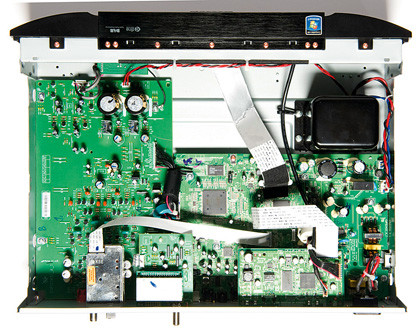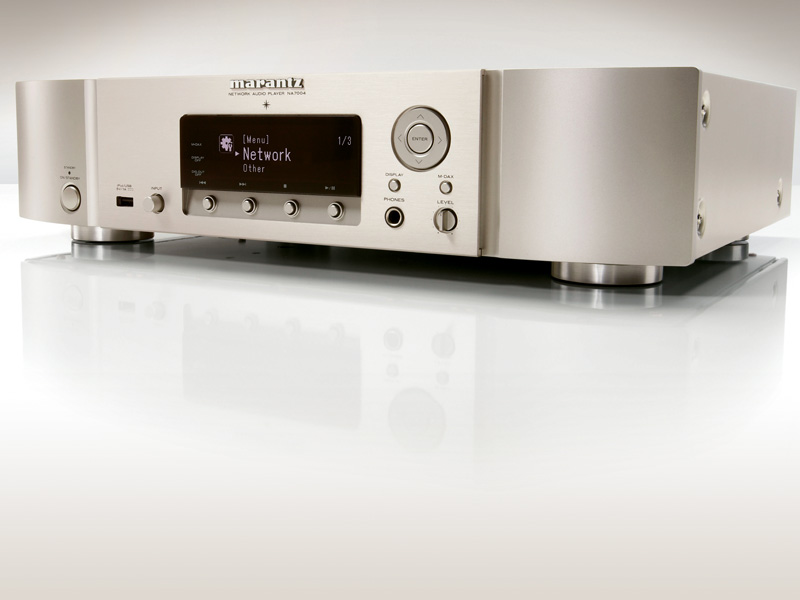TechRadar Verdict
Pros
- +
Slick operation
- +
Good sound through digital output
Cons
- -
Built-in Wi-Fi would make it fully competitive
Why you can trust TechRadar
Given its very reasonable price and wide-ranging capabilities, the Marantz NA7004 network audio player might well tempt those who have not yet sampled the delights of networked music.
Be warned, though, that despite its size and weight this is not an all-in-one player like the Arcam Solo Neo or the NaimUniti.
There is no amplifier lurking inside the case to drive your loudspeakers… the most it will accomplish is powering your headphones. It simply provides a line-level analogue output to feed music to your preamplifier/amplifier and a digital output to supply a DAC or digital recorder.
What makes it especially appealing, though, is the ease with which it integrates into any home network/hi-fi system and its extremely user-friendly approach to what can sometimes be a tricky discipline to get your head around.
Introducing Apple Airplay
Recently, however, the NA7004 has become even more accommodating thanks to the inclusion of Apple's AirPlay wireless connectivity. This technology means that you can wirelessly transmit music from your iTunes library (be it on a laptop, desktop PC, iPod/Phone/Pad) to your NA7004 and so listen to it through your hi-fi system.
You can play and control the music with your iPhone or any i device running the iOS4.2 operating software. Marantz also has a system remote control app for the ubiquitous iPhone called Wizz – no puns intended – for your added couch potato convenience.
Sign up for breaking news, reviews, opinion, top tech deals, and more.
The NA7004 user manual is a weighty tome. It needs to be, because this unit offers such a wealth of features that need documenting. It is rather like the audio version of the Swiss Army knife.
As well as its network capability, it also offers: AM/FM radio; DAB radio; internet radio; Napster; Last.FM; USB playback – for memory stick and computer and, of course, the NA7004 can also operate as a stand-alone DAC using its integral Cirrus Logic CS4398 chipset. The DAC will handle signals at sampling frequencies up to 192kHz through the co-axial and optical inputs and up to 96kHz through its USB port.

The USB connection seems to have been better implemented than some we have encountered to date: it was completely free from noise suggesting that Marantz has taken great care over the power supply arrangements.
The NA7004 boasts HDAM-SA2 (Hyper Dynamic Amplifier Module) circuits in its analogue output stage, along with M-DAX (Marantz Dynamic Audio Expander) processing to 'optimise' data-reduced audio sources such as MP3 and AAC files.
This is said to compensate for the high-frequency roll-off in such files, and has a three-position selector. We found it to be musically pretty ineffectual, even when listening to MP3s from an iPhone. Switching it on merely introduced slight tonal variations and occasionally created an impression of enhanced vitality in a mix, but it was not something that we felt we could never live without.
This, of course, may not be a feature aimed at audiophiles who should rip losslessly, but it may help mainstream users with compressed collections.
The unit fared much better rendering higher-quality uncompressed files from our NAS drives. Presentation wasn't extreme high-end, but it was more than acceptable. Bass sometimes appeared poorly defined, although quite weighty and the top end did not have outstanding cut or presence, but the music's fundamentals were adequately portrayed.
What really and truly delighted us was the sheer ease, simplicity and reliability with which the NA7004 switched between its selection of inputs: it provided carefree access to an endless variety and flow of music at the touch of the input button.
Marantz has even considered users who have no home network: they can simply connect the NA7004 through a USB cable to their PC and the PC will recognize the NA7004 as an external sound card. You can then pipe music from your computer to your hi-fi .
Not a case full of air…
There is a definite pride of ownership vibe about this unit. Despite being inexpensive, it looks, and is, very elegant. Furthermore, it is robustly built.
It is also reassuringly simple to operate. Turn the rotary input selector and the central display indicates the chosen input, while the menu control to the right allows you to access selections applicable to that input: for instance, if you have opted for Music Server, this will let you scroll through the available UPnP (Universal Plug and Play) or DLNA servers to which you can connect.
Input connection was not always as immediate as we would have liked. It took a few moments before you'd hear any music with some inputs, because there is a lot going on 'in the background'.
Inside the chassis you will find more than the usual Mini-ITX circuit board found in many products. The circuitry is, in fact, contained on eight individual PCBs, in total filling the enclosure. The only gap where there is no PCB is occupied by a substantial mains transformer.
Digital beats analogue
The most important function of the NA7004 is the way it replays music off a NAS or local computer. The news here is good: access through Ethernet is totally painfree and reasonably quick, even when enumerating thousands of tracks – mostly regular CD rips, but also a great many high-resolution 24-bit/96kHz downloads with a few MP3s thrown in for good measure.
Listening to the unit through its analogue connection gives results that often seem warm and gentle in character, although rather inconsistent, varying from one album to another. Some appear shouty and unrefined by contrast. Bass, though, seems stodgy and overblown.

The cure for these ills is bypassing the analogue outputs and feeding a digital signal straight to a DAC. The presentation immediately improves dramatically – the NA7004 becoming far more even-handed in the way it presents tracks and is more consistently balanced across all its inputs.
The player does show an especially appealing way with voices, rendering vocalists and radio announcers with realism and authority. We were occasionally convinced that the voice we heard was that of another person in the room and not a comment issuing from the loudspeakers.
Its internet radio performance is also impressive, as is its showing with streaming services such as Napster and Last.FM. iPod and iPhone users will enjoy its brisk, full-blooded and detailed presentation, especially with lossless AIFF files, heard either through the USB/iPod wired input or by way of Airplay. It even sounds enjoyable playing 320kbps MP3s through the hi-fi . There, we said it.
Hi-tech romance
We enjoyed the NA7004, especially when listening through its digital output. It is delightfully easy to operate and it integrates with both hi-fi systems and computer networks with "your-Grandma-could- do-it" ease.
AirPlay functionality makes this a simple streamer for the uninitiated. An iPod can effectively be 'docked' yet still be in your pocket – the height of convenience.
What is more, the unit is aesthetically restrained and subtle and so should look comfortably at home in any equipment rack. This is a product that virtually demands our recommendation.
Follow TechRadar Reviews on Twitter: http://twitter.com/techradarreview
